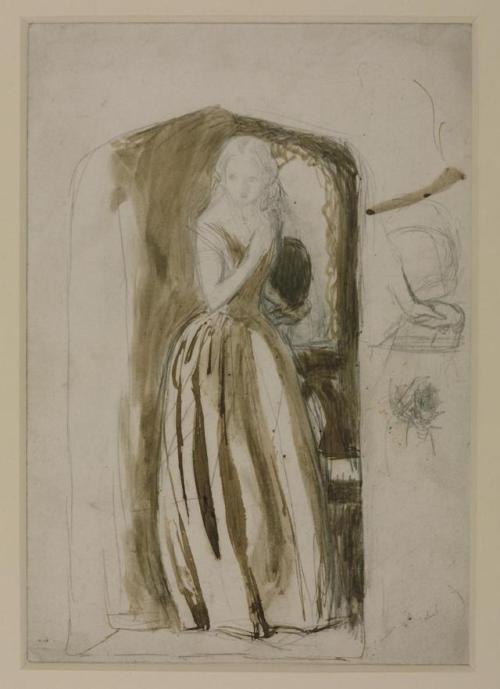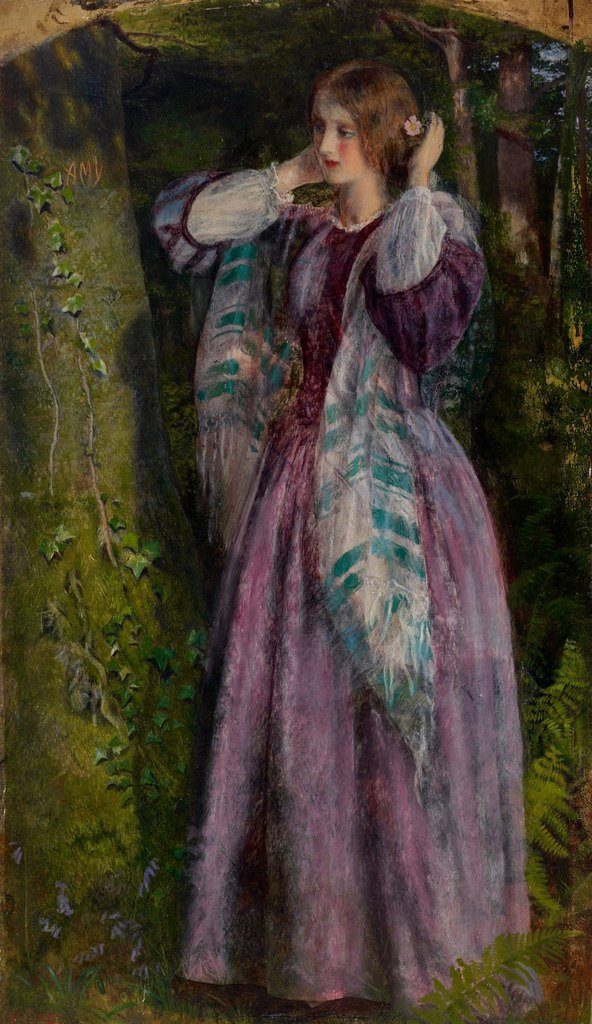Let’s take a look at some very romantical paintings by a Pre-Raphaelite painter Arthur Hughes.
 Arthur Hughes, April Love, 1855-56
Arthur Hughes, April Love, 1855-56
On 19th May 1855, Edward Burne-Jones, English painter associated with the later phase of the Pre-Raphaelite Movement, took his beloved girl Georgiana “Georgie” MacDonald to the Royal Academy Exhibition and proposed marriage to her in front of the painting “April Love” by Arthur Hughes. What a romantical gesture!? I have always been fond of this painting because of its dreamy and romantic mood and the gorgeous indigo-purple dress that the girl is wearing. Purple dresses are somewhat rare in art history, and interestingly Arthur Hughes’s canvases are full of them. Sweet and wistful coppery-haired maidens in purple gowns, against a background of lush green nature. Very romantic and very Pre-Raphaelite. Hughes is famous for making paintings of lovers, influenced by a painting that he himself admired, “The Huguenot” by John Everett Millais, but he is also somewhat ignored, perhaps because his life wasn’t rife with scandals, lovers or travels to exotic places. He led a quiet, but joyous and serene life with his wife Tryphena Foord ‘his early and only love’ and they married in 1855, so around the time “April Love” was painted.

Arthur Hughes, Study for April Love, 1855
It’s interesting to note that Arthur Hughes’ own love life was happy and seemingly ideal, and yet the romantic scenes on his canvases are tinged with melancholy and unrequited feelings; transient nature of love and life are in opposition with the lasting character of nature, old oak trees and ivy with its steady and persistent growth are in contrast with the changing nature of human feelings. Maybe in his real life, love was as strong as an oak trees and could resist winds and storms, but in the gentle, dreamy and wistful world of his paintings, love is a light pink rose whose delicate petals are easily scattered by a gentle breeze, as we can see in the bottom left part of the painting “April Love” where a girl is standing by an ivy-overgrown tree trunk and looking down in disappointment and sadness, while a gentleman whose head is hard to even notice on canvas is kissing her hand and perhaps reassuring her that she is wrong in her doubts and that he does love her. The model for the lad was the sculptor Alexander Munro who shared a studio with Hughes from 1852 to 1858, and the model for the girl was originally a girl from the countryside who refused to pose for Hughes after she saw the way he had drawn her. Hughes then used his wife as a model and it is her face that we see on the canvas, so gentle and so suitable for a romantic scene. The painting was exhibited in 1856 and accompanied with these verses from Lord Tennyson’s poem “The Miller’s Daughter”:
Love is hurt with jar and fret,
Love is made a vague regret,
Eyes with idle tears are set,
Idle habit links us yet;
What is Love? For we forget.
Ah no, no.

Arthur Hughes, Amy, 1853-59
Arthur Hughes was not an official member of the Pre-Raphaelite Brotherhood, but his paintings clearly exhibit the Pre-Raphaelite style and preference of themes. Another painting, “Amy”, is also a beautiful example of Hughes’ use and choice of colours; how radiant and vivacious is the purple of her dress?! Especially in the contrast with the many shades of green of the ivy, moss and fern all around her. The rosy-cheeked Amy with a flower in her hair could be mistaken for a forest fairy. Her eyes are worryingly set on the name “Amy” freshly carved on the tree trunk. Youthful love is fragile and somewhere deep in her heart she can sense it. In a follow-up painting “Long Engagement” we see the same girl, this time with a far sadder look on her face, disappointment and pleading are in her gaze. His eyes are directed somewhere else, perhaps he doesn’t have the heart to break hers and shatter her hopes, or there is reluctance which keeps him from fulfilling his promise. Meanwhile, the carved name on the tree trunk is getting more and more overgrown with ivy. Ferns and moss have grown in abundance, and white roses with their thorny stems have started to smother the paths of the forest. The lovers’ love is lulled to everlasting sleep. Despite the sad element of Hughes’ paintings, they are still a definite proof that broodiness and melancholy are cool, and happiness is not. Also, it’s interesting to note that the couple mentioned in the beginning, Edward Burne-Jones and Georgie, also had a long engagement which made Georgie’s heart ache, but in 1860 they finally married, and luckily avoided the fate of the couple bellow.

Arthur Hughes, Long Engagement, 1859


